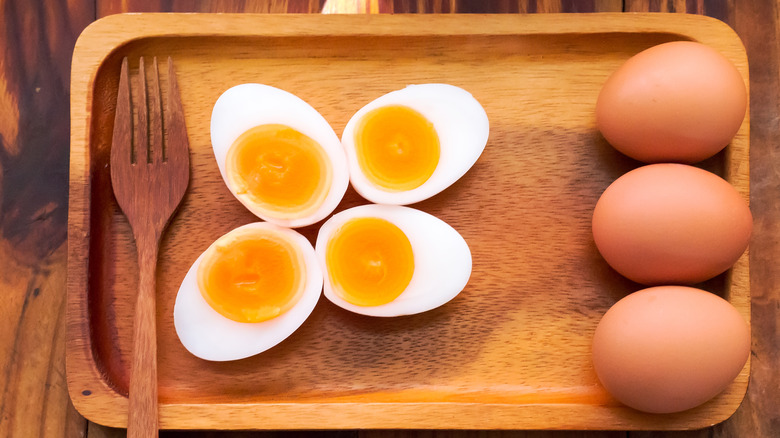The Textural Difference Between Steamed And Boiled Eggs
Mastering the ideal cooking technique for various egg preparations is a challenge that is often accepted flippantly but proves to be a surprisingly worthy adversary to chefs and home cooks alike. From broken yolks to peeling problems, cooking a perfect egg takes practice, patience, and a willingness to try tips and tricks from those on a similar egg quest. In the end, discovering the cooking method that yields an egg with an ideal texture and flavor makes the journey worth it.
One might think that a simple boiled egg is the easiest way to cook an incredible edible. One might think. The elusive egg strikes again with various issues there as well. There's that unappetizing gray ring around the yolk that UNL Food attributes to a chemical reaction between the iron and sulfur inside an egg that discolors the yolk when overcooked. This can be avoided by watching the clock while boiling and then shocking the eggs in an ice-water bath to stop the cooking process.
Next, you are faced with the often frustrating task of peeling those shells. The Cookful notes that temperature comes into play here also and that the consistently high heat applied when steaming an egg keeps the egg white from sticking to the thin membrane between the white and the eggshell. Troubleshooting tricks abound for steaming and boiling preparations, but which method yields that ideal mouthfeel when you finally get to eat your eggs?
Steaming yields a creamier egg
Gone are the days of relying on one method to cook your food (thanks air fryers), and boiled eggs are no exception to the foods that have had their primary cooking technique altered. According to MasterClass, cooks can achieve a soft, medium, or hard boil on an egg by traditionally boiling it in water or steaming it, but the notable difference is in the resulting texture.
The classic method of boiling an egg directly in hot bubbling water is a less gentle way to cook a delicate egg. When you plunk your cold eggs in hot water, it alters the temperature and cooking time, leading to inconsistent results. Boiling eggs involve them being in direct contact with bubbling water, which can be a rough way to cook a delicate food. Steaming, on the other hand, keeps the eggs just above the boiling water, where they are immediately subjected to high, consistent heat and can't be jostled around by boiling water.
USA Today notes that the unaltered temperature and tameness of steaming an egg is the key to the most delicious texture. Hot steam stays hot even after placing the eggs over it and gently envelops the egg, efficiently cooking it without overdoing it. Where a boiled egg can suffer from a rubbery white and a dry yolk, a gently steamed egg yields a delicate white with a rich and creamy yolk that melts into the palate.

